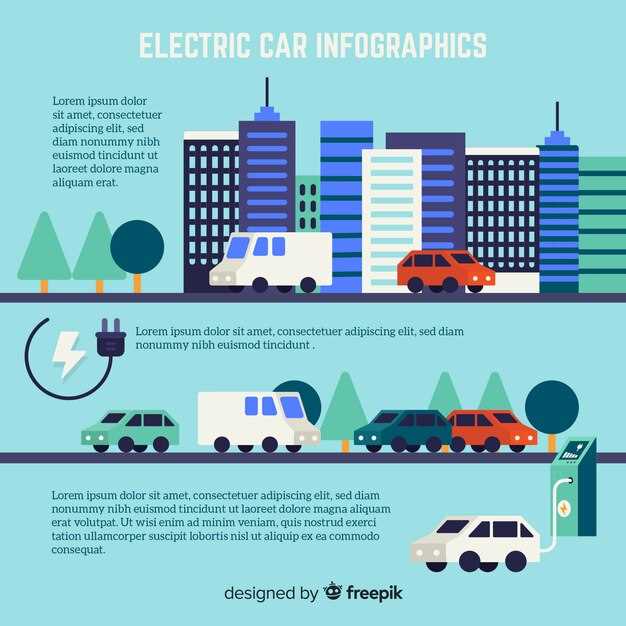Incentives play a key role in expanding electric vehicle (EV) adoption. Countries worldwide are implementing tax breaks, rebates, and grants that make purchasing EVs more appealing. For example, the United States offers a federal tax credit of up to $7,500 for qualifying electric cars, significantly lowering the overall cost for consumers.
Charging infrastructure is another priority for many governments. Investing in extensive charging networks resolves range anxiety, making EVs a practical option for a growing number of drivers. The European Commission has proposed plans to install over 1 million public chargers by 2025, ensuring accessibility and convenience for users.
Collaboration with private sectors enhances the impact of government initiatives. Public-private partnerships drive innovation in battery technology and charging solutions. Countries like Norway have successfully partnered with energy companies to expand charging stations, leading to one of the highest EV penetration rates globally.
Education and outreach programs are equally important. Governments can promote awareness about the benefits of EVs through campaigns, workshops, and community events. By informing potential buyers about available incentives and environmental advantages of EVs, they can stimulate greater interest and demand.
Financial Incentives for Consumers: Tax Credits and Rebates
Consumers should explore tax credits and rebates to reduce the upfront cost of electric vehicles (EVs). Many governments offer significant financial incentives to encourage adoption.
- Federal Tax Credit: In the United States, buyers can receive a tax credit ranging from $2,500 to $7,500 based on the vehicle’s battery capacity. This credit directly reduces federal tax liability, turning an expensive purchase into a more manageable expense.
- State Incentives: Numerous states provide additional credits or rebates. For example, California offers rebates up to $2,000 for eligible EVs. Check local regulations, as these vary widely.
- Utility Company Rebates: Some utility providers offer incentives for EV purchases or charging equipment installation. Rebates can reach several hundred dollars, making EV charging more affordable.
Review eligibility requirements for each incentive. For federal and state credits, you typically need to file specific forms during tax season. Stay informed about changes in legislation that might increase or decrease available benefits.
Consider pairing these financial incentives with low-interest financing options. Many dealerships offer financing specifically for electric vehicle purchases, which can further reduce the overall cost.
Take advantage of these financial benefits today. Calculate how much you can save through available incentives and make informed choices that fit your budget and driving needs. EV ownership is more accessible than ever with the support from government programs.
Charging Infrastructure Development: Government Partnerships and Investments
Governments should prioritize investments in charging infrastructure by forming partnerships with private companies. These collaborations can streamline the deployment of charging stations across urban and rural areas. Local governments can identify high-traffic locations, ensuring charging stations are accessible to the public.
For instance, public-private partnerships can significantly reduce the financial burden on taxpayers. By sharing costs, governments and businesses can install more charging points faster. Offering incentives to private companies, such as tax breaks or grants, encourages them to participate actively in the development of this infrastructure.
Tracking and analyzing usage data from existing charging stations helps in planning future installations. By understanding peak usage times and user behavior, authorities can strategically place new chargers in locations that meet demand.
Collaboration with utility companies also plays a key role. Governments can work with utilities to ensure an adequate power supply to charging stations, minimizing strain on the grid. Implementing smart grid technology can optimize energy distribution, making charging stations more efficient and reliable.
In addition, establishing uniform charging standards can help create a seamless experience for EV users. Governments should advocate for standardized technology across networks, making it easier for drivers to charge their vehicles without compatibility issues.
Lastly, public awareness campaigns will encourage EV adoption. By informing citizens about the availability of charging infrastructure and incentives for electric vehicles, governments can stimulate interest in transitioning to electric mobility. Engaging communities through outreach programs can further enhance acceptance and excitement around electric vehicles.
Regulatory Measures: Emission Standards and EV Mandates
Implement stringent emission standards to incentivize electric vehicle (EV) adoption. Countries such as Norway have set ambitious targets, aiming for 100% of new cars sold to be zero-emission by 2025. This initiative urges manufacturers to innovate and produce more electric models, significantly lowering overall emissions.
Introduce EV mandates that require automakers to meet specific sales targets for electric models. California’s mandate, for instance, requires a percentage of sales from zero-emission vehicles, pushing manufacturers towards electrification. This regulation spurs competition and innovation in the industry while providing consumers with a broader selection of electric options.
Utilize carbon pricing mechanisms to make fossil fuel vehicles less economically attractive. An increasing carbon tax accelerates the shift to electric models by making traditional combustion engines more expensive to operate and maintain.
Encourage technology development through regulatory frameworks that support research and development initiatives for electric batteries and charging infrastructure. Grants and tax incentives for companies investing in battery technology can significantly enhance EV performance and reduce costs.
Establish regional emission reduction targets that align with global climate agreements. These targets put pressure on both manufacturers and consumers to transition to electric vehicles, fostering a collective effort towards sustainability.
Monitor and adapt regulations as market conditions evolve. Regular assessments ensure that rules remain relevant and effective, enabling stakeholders to react swiftly to technological advancements and changing consumer preferences.
Public Awareness Campaigns: Educating Citizens on EV Benefits
Target local communities with interactive workshops that showcase the advantages of electric vehicles (EVs). These sessions can include hands-on demonstrations, allowing participants to experience EV technology firsthand. Highlight savings on fuel costs and maintenance over time compared to traditional vehicles. Provide data-driven comparisons to illustrate the environmental impact, such as reduced emissions and energy efficiency.
Leverage social media platforms to spread information quickly and effectively. Create engaging content that includes infographics and video testimonials from EV owners. Sharing real-life experiences can significantly influence potential buyers. Host online Q&A sessions, where experts can answer common questions and dispel myths surrounding EVs, making citizens feel more informed and empowered.
Collaborate with local businesses and organizations to create promotional events, such as EV test drive days. These events can encourage people to explore various models available in the market. Partnering with local influencers can enhance credibility, attracting a broader audience eager to learn about sustainable transport options.
Develop educational materials that are easy to understand, focusing on specific benefits like tax credits and government incentives available for EV purchasers. Distribute brochures or flyers in public spaces, emphasizing how transitioning to electric driving contributes to community health and environmental preservation.
Track the effectiveness of campaigns through surveys and feedback. Understanding public perception and knowledge gaps can help tailor future initiatives, ensuring they resonate well and lead to increased EV adoption rates in the community.
Support for Manufacturers: Grants and Subsidies for EV Production
Governments actively provide grants and subsidies to support electric vehicle (EV) manufacturers, enabling them to scale production and innovate. Manufacturers can benefit from federal grants specifically targeting research and development initiatives, which often cover essential aspects like battery technology and vehicle design.
For direct financial assistance, many regions offer production subsidies that lower operational costs. These funds help manufacturers expand their factories, hire more personnel, and accelerate output. For example, certain states in the U.S. have launched programs that reimburse a percentage of production costs, significantly easing financial pressure.
Tax incentives add another layer of support. These can include tax credits based on the number of EVs produced or sold, which improve profitability. Companies can also receive deductions for investments in renewable energy sources used during the manufacturing process.
Collaboration with universities and research institutions is encouraged, as grants often facilitate partnerships aimed at technological advancements. Such alliances can enhance a manufacturer’s competitiveness by developing cutting-edge solutions tailored for the EV market.
Additionally, some governments implement loan programs with favorable terms for manufacturers seeking to upgrade facilities or invest in new technologies. These loans allow companies to make significant changes without immediate financial strain.
Participating in government-sponsored competitions or initiatives can provide manufacturers with visibility and additional funding opportunities. These programs often emphasize innovation and sustainability, aligning with the global push for greener vehicles.
Overall, leveraging these financial resources enables manufacturers to contribute to a more sustainable future while maintaining competitiveness in the rapidly growing EV sector.
Research and Development Funding: Innovating EV Technologies
Allocate a specific percentage of national budgets to R&D initiatives targeting electric vehicle technology. Governments should aim for at least 5% of total transportation budgets. This funding can drive advancements in battery efficiency, charging infrastructure, and lightweight materials, significantly enhancing EV performance and reducing costs.
Develop partnerships with universities and private research institutions. Collaborative projects can yield innovative solutions while leveraging the unique expertise from academia and industry. These partnerships can attract additional funding from private investors and international grants, amplifying the impact of public investment.
Encourage competitive grants for startups focusing on breakthrough technologies in the EV sector. Developing competitions that reward innovative ideas can spur creativity and rapid development of new technologies. Winners can receive seed funding, mentorship, and access to necessary resources to scale their solutions effectively.
Create tax incentives for companies investing in R&D for electric vehicles. This approach reduces financial barriers for businesses and motivates them to prioritize research projects. Clear guidelines and benchmarks will help track the progress and return on investment for such incentives.
Prioritize funding for projects addressing charging solutions and range extension. Research into solid-state batteries, ultra-fast charging stations, and energy recovery systems can significantly improve consumer confidence and convenience. The goal should be reducing charging time and expanding driving ranges to match or exceed traditional vehicles.
Incorporate sustainability metrics into R&D funding criteria. Funding should not only focus on technological improvements but also on reducing environmental footprints. Supporting projects aimed at recycling batteries and utilizing sustainable materials will foster a healthier ecosystem for future generations.
Streamline regulatory processes for research initiatives. By eliminating unnecessary bureaucratic hurdles, governments can expedite the development and deployment of innovative technologies. A nimble regulatory framework allows for quicker adaptation to new findings and technologies in the EV sector.
Host annual EV innovation summits to showcase successful projects and foster knowledge sharing. These events can connect stakeholders across the industry, presenting opportunities for collaboration and new ventures. Bringing together policymakers, researchers, and industry leaders accelerates the transfer of innovative ideas and solutions.







